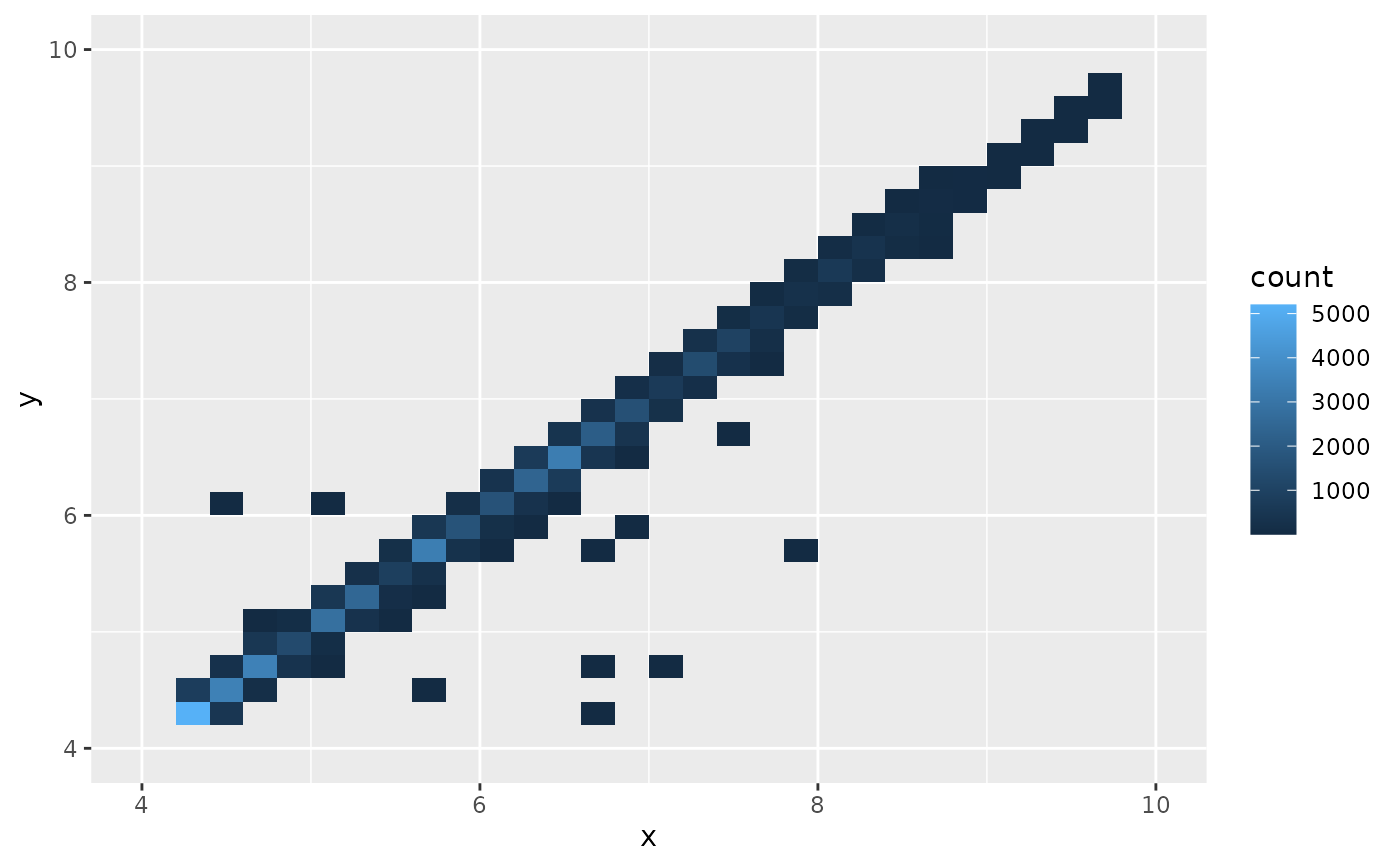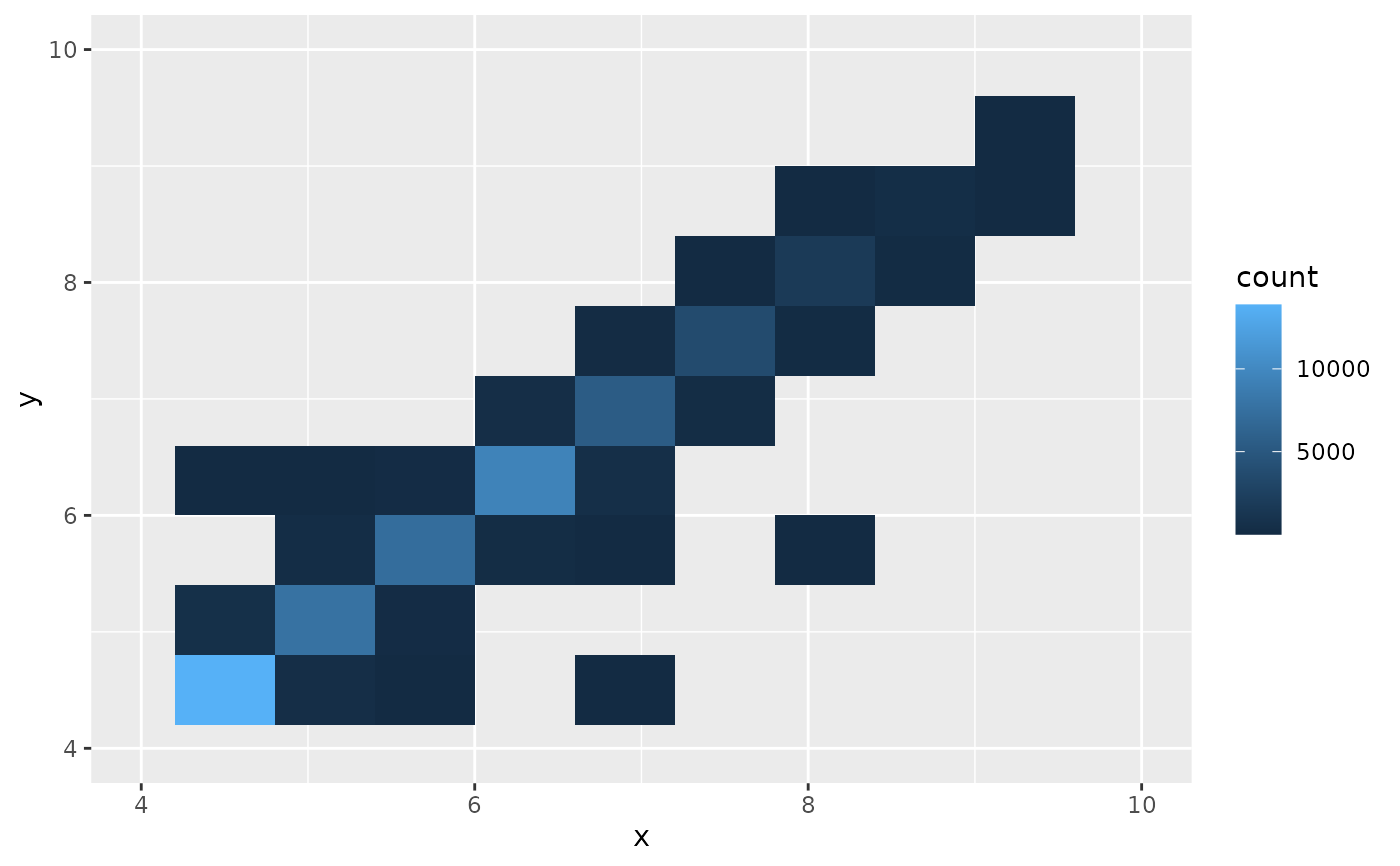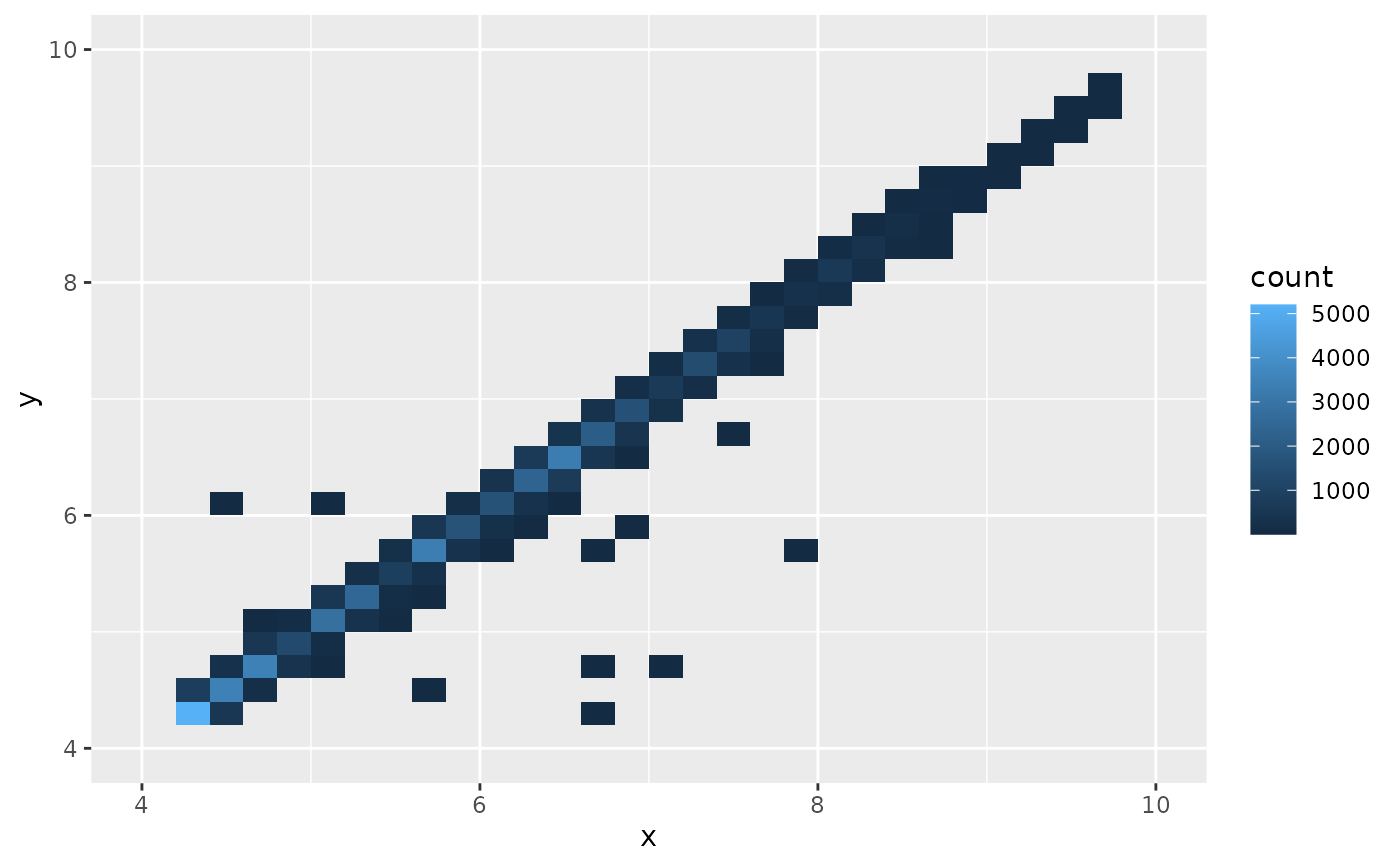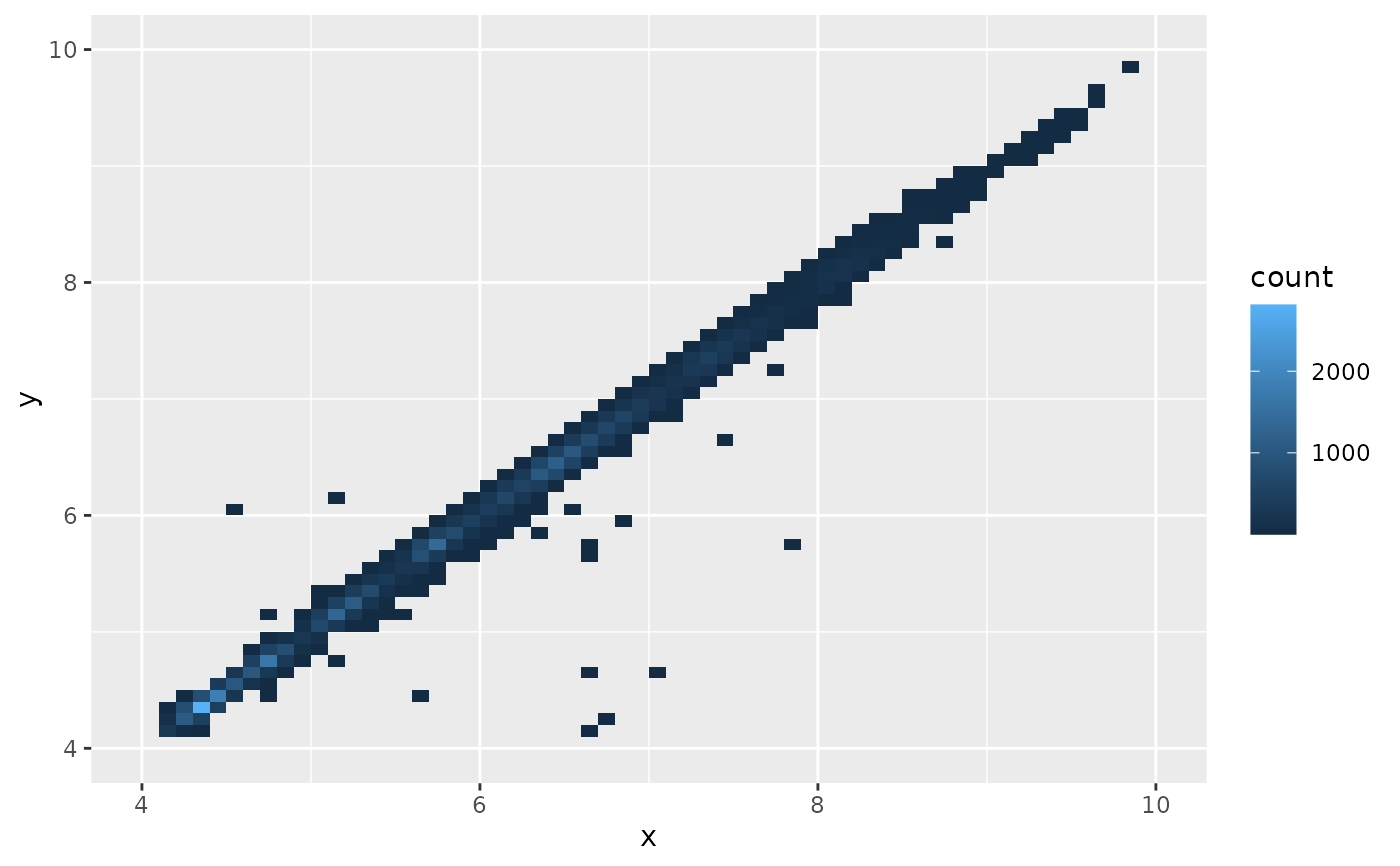Divides the plane into rectangles, counts the number of cases in
each rectangle, and then (by default) maps the number of cases to the
rectangle's fill. This is a useful alternative to geom_point()
in the presence of overplotting.
Usage
geom_bin_2d(
mapping = NULL,
data = NULL,
stat = "bin2d",
position = "identity",
...,
lineend = "butt",
linejoin = "mitre",
na.rm = FALSE,
show.legend = NA,
inherit.aes = TRUE
)
stat_bin_2d(
mapping = NULL,
data = NULL,
geom = "tile",
position = "identity",
...,
binwidth = NULL,
bins = 30,
breaks = NULL,
drop = TRUE,
boundary = NULL,
closed = NULL,
center = NULL,
na.rm = FALSE,
show.legend = NA,
inherit.aes = TRUE
)Arguments
- mapping
Set of aesthetic mappings created by
aes(). If specified andinherit.aes = TRUE(the default), it is combined with the default mapping at the top level of the plot. You must supplymappingif there is no plot mapping.- data
The data to be displayed in this layer. There are three options:
NULL(default): the data is inherited from the plot data as specified in the call toggplot().A
data.frame, or other object, will override the plot data. All objects will be fortified to produce a data frame. Seefortify()for which variables will be created.A
functionwill be called with a single argument, the plot data. The return value must be adata.frame, and will be used as the layer data. Afunctioncan be created from aformula(e.g.~ head(.x, 10)).
- position
A position adjustment to use on the data for this layer. This can be used in various ways, including to prevent overplotting and improving the display. The
positionargument accepts the following:The result of calling a position function, such as
position_jitter(). This method allows for passing extra arguments to the position.A string naming the position adjustment. To give the position as a string, strip the function name of the
position_prefix. For example, to useposition_jitter(), give the position as"jitter".For more information and other ways to specify the position, see the layer position documentation.
- ...
Other arguments passed on to
layer()'sparamsargument. These arguments broadly fall into one of 4 categories below. Notably, further arguments to thepositionargument, or aesthetics that are required can not be passed through.... Unknown arguments that are not part of the 4 categories below are ignored.Static aesthetics that are not mapped to a scale, but are at a fixed value and apply to the layer as a whole. For example,
colour = "red"orlinewidth = 3. The geom's documentation has an Aesthetics section that lists the available options. The 'required' aesthetics cannot be passed on to theparams. Please note that while passing unmapped aesthetics as vectors is technically possible, the order and required length is not guaranteed to be parallel to the input data.When constructing a layer using a
stat_*()function, the...argument can be used to pass on parameters to thegeompart of the layer. An example of this isstat_density(geom = "area", outline.type = "both"). The geom's documentation lists which parameters it can accept.Inversely, when constructing a layer using a
geom_*()function, the...argument can be used to pass on parameters to thestatpart of the layer. An example of this isgeom_area(stat = "density", adjust = 0.5). The stat's documentation lists which parameters it can accept.The
key_glyphargument oflayer()may also be passed on through.... This can be one of the functions described as key glyphs, to change the display of the layer in the legend.
- lineend
Line end style, one of
"round","butt"or"square".- linejoin
Line join style, one of
"round","mitre"or"bevel".- na.rm
If
FALSE, the default, missing values are removed with a warning. IfTRUE, missing values are silently removed.- show.legend
Logical. Should this layer be included in the legends?
NA, the default, includes if any aesthetics are mapped.FALSEnever includes, andTRUEalways includes. It can also be a named logical vector to finely select the aesthetics to display. To include legend keys for all levels, even when no data exists, useTRUE. IfNA, all levels are shown in legend, but unobserved levels are omitted.- inherit.aes
If
FALSE, overrides the default aesthetics, rather than combining with them. This is most useful for helper functions that define both data and aesthetics and shouldn't inherit behaviour from the default plot specification, e.g.annotation_borders().- geom, stat
Use to override the default connection between
geom_bin_2d()andstat_bin_2d(). For more information about overriding these connections, see how the stat and geom arguments work.- binwidth
The width of the bins. Can be specified as a numeric value or as a function that takes x after scale transformation as input and returns a single numeric value. When specifying a function along with a grouping structure, the function will be called once per group. The default is to use the number of bins in
bins, covering the range of the data. You should always override this value, exploring multiple widths to find the best to illustrate the stories in your data.The bin width of a date variable is the number of days in each time; the bin width of a time variable is the number of seconds.
- bins
Number of bins. Overridden by
binwidth. Defaults to 30.- breaks
Alternatively, you can supply a numeric vector giving the bin boundaries. Overrides
binwidth,bins,center, andboundary. Can also be a function that takes group-wise values as input and returns bin boundaries.- drop
if
TRUEremoves all cells with 0 counts.- closed
One of
"right"or"left"indicating whether right or left edges of bins are included in the bin.- center, boundary
bin position specifiers. Only one,
centerorboundary, may be specified for a single plot.centerspecifies the center of one of the bins.boundaryspecifies the boundary between two bins. Note that if either is above or below the range of the data, things will be shifted by the appropriate integer multiple ofbinwidth. For example, to center on integers usebinwidth = 1andcenter = 0, even if0is outside the range of the data. Alternatively, this same alignment can be specified withbinwidth = 1andboundary = 0.5, even if0.5is outside the range of the data.
Computed variables
These are calculated by the 'stat' part of layers and can be accessed with delayed evaluation.
after_stat(count)
number of points in bin.after_stat(density)
density of points in bin, scaled to integrate to 1.after_stat(ncount)
count, scaled to maximum of 1.after_stat(ndensity)
density, scaled to a maximum of 1.
Controlling binning parameters for the x and y directions
The arguments bins, binwidth, breaks, center, and boundary can
be set separately for the x and y directions. When given as a scalar, one
value applies to both directions. When given as a vector of length two,
the first is applied to the x direction and the second to the y direction.
Alternatively, these can be a named list containing x and y elements,
for example list(x = 10, y = 20).
See also
stat_bin_hex() for hexagonal binning
Aesthetics
geom_bin2d() understands the following aesthetics. Required aesthetics are displayed in bold and defaults are displayed for optional aesthetics:
| • | x | |
| • | y | |
| • | alpha | → NA |
| • | colour | → via theme() |
| • | fill | → via theme() |
| • | group | → inferred |
| • | height | → 1 |
| • | linetype | → via theme() |
| • | linewidth | → via theme() |
| • | width | → 1 |
Learn more about setting these aesthetics in vignette("ggplot2-specs").
Examples
d <- ggplot(diamonds, aes(x, y)) + xlim(4, 10) + ylim(4, 10)
d + geom_bin_2d()
#> `stat_bin2d()` using `bins = 30`. Pick better value `binwidth`.
#> Warning: Removed 478 rows containing non-finite outside the scale range
#> (`stat_bin2d()`).
#> Warning: Removed 5 rows containing missing values or values outside the scale
#> range (`geom_bin2d()`).
 # You can control the size of the bins by specifying the number of
# bins in each direction:
d + geom_bin_2d(bins = 10)
#> Warning: Removed 478 rows containing non-finite outside the scale range
#> (`stat_bin2d()`).
# You can control the size of the bins by specifying the number of
# bins in each direction:
d + geom_bin_2d(bins = 10)
#> Warning: Removed 478 rows containing non-finite outside the scale range
#> (`stat_bin2d()`).
 d + geom_bin_2d(bins = list(x = 30, y = 10))
#> Warning: Removed 478 rows containing non-finite outside the scale range
#> (`stat_bin2d()`).
#> Warning: Removed 2 rows containing missing values or values outside the scale
#> range (`geom_bin2d()`).
d + geom_bin_2d(bins = list(x = 30, y = 10))
#> Warning: Removed 478 rows containing non-finite outside the scale range
#> (`stat_bin2d()`).
#> Warning: Removed 2 rows containing missing values or values outside the scale
#> range (`geom_bin2d()`).
 # Or by specifying the width of the bins
d + geom_bin_2d(binwidth = c(0.1, 0.1))
#> Warning: Removed 478 rows containing non-finite outside the scale range
#> (`stat_bin2d()`).
# Or by specifying the width of the bins
d + geom_bin_2d(binwidth = c(0.1, 0.1))
#> Warning: Removed 478 rows containing non-finite outside the scale range
#> (`stat_bin2d()`).

